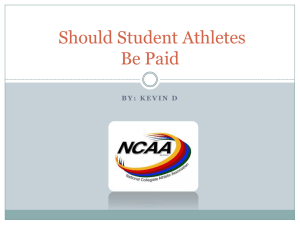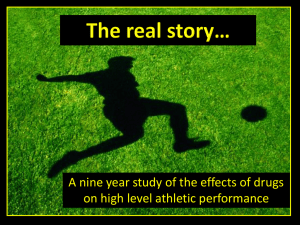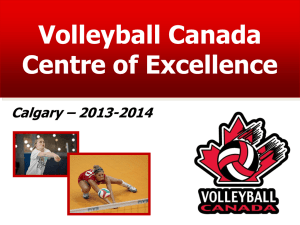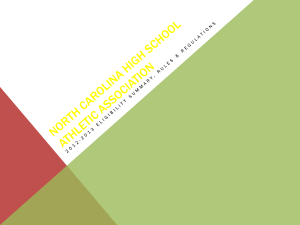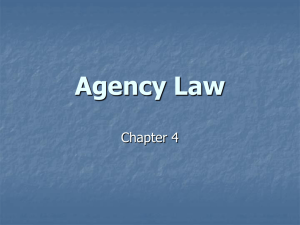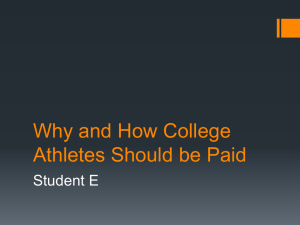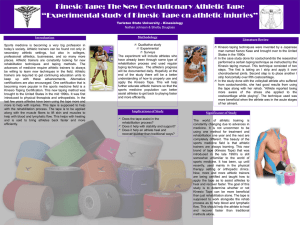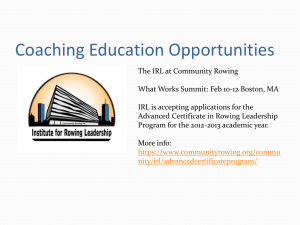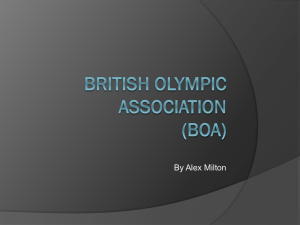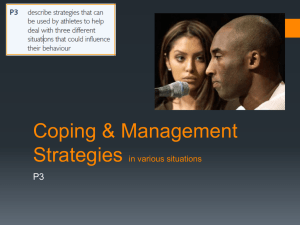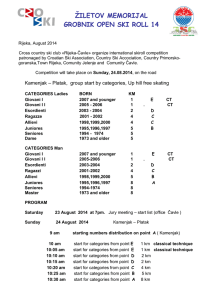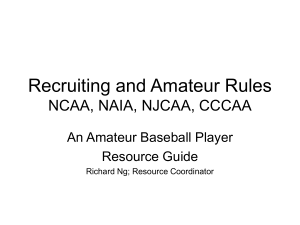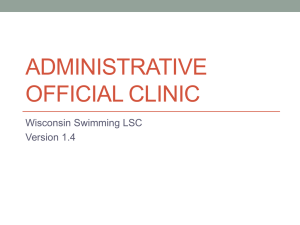Welcome to MSJC!
advertisement
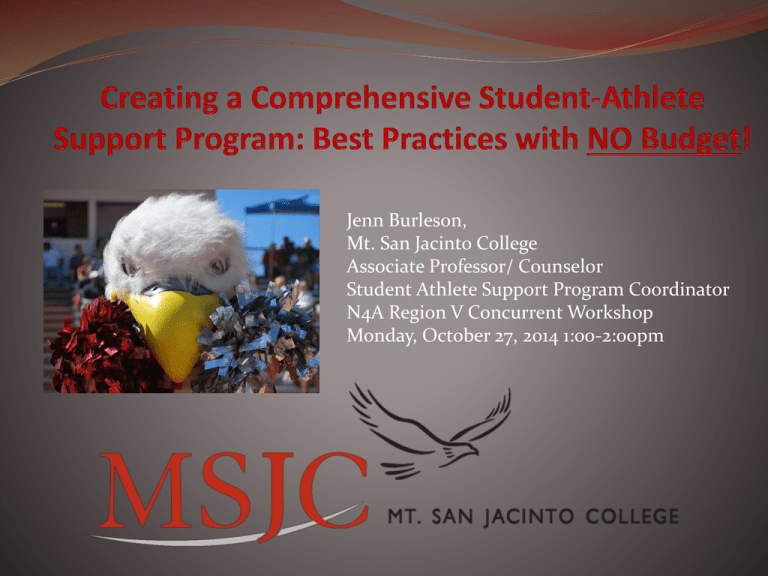
Jenn Burleson, Mt. San Jacinto College Associate Professor/ Counselor Student Athlete Support Program Coordinator N4A Region V Concurrent Workshop Monday, October 27, 2014 1:00-2:00pm Objectives for Today’s Workshop - To explore a comprehensive community college student athlete support program developed with NO BUDGET - To determine the benefits for creating a comprehensive support program for student athletes - To discuss possible funding sources currently in your district to maximize academic support for student athletes - To share best practice ideas to increase student athlete success at your colleges Why is this important for Two Year College Transfers? NCAA ACADEMIC REFORM DIVISION I Have a 2.500 GPA in all transferable hours. All students are limited to two physical education credit hours from the two-year college to meet credit and GPA requirements. Exception for PE majors but there will still be some sort of limit for PE activity units What are the benefits? Increase retention rates of 2 year college student athletes Increase persistence rates of 2 year college student athletes Increase graduation rates for 2 year college transfer student athletes Increase student athlete success rates Student athletes are properly learning basic skills they were lacking prior to college enrollment Student athletes are able to stick with their intended major of choice Creating a culture of future college educated adult student athlete advocates Mt. San Jacinto College (MSJC) Student Athlete Population 2013-2014 Academic Year 11 sports 860 unduplicated head count inquiring about intercollegiate athletics 2880 duplicated headcount student athletes received athletic counseling services 227 student athletes (actually played) 197 students assessed at MSJC using the ACCUPLACER ASSESSMENT Out of the 197 that assessed, 189 placed into basic skills classes (Math, English and/or Reading) 96% of student athletes at MSJC assess into basic skills/ remedial classes In the beginning… 1 Part-time (21 hrs per week) athletic counselor Educational Plans Only No program in place No academic support for student athletes No true vision for student athlete success on the academic side of the house NO BUDGET!!! Creating a Vision Link to the colleges mission , strategic plan, and educational master plan Student Athlete Support Program Vision The vision of the Student Athlete Support Program is to provide the necessary support to assist all student athletes in reaching their full potential academically and personally. This proactive program motivates and assists student-athletes to make successful transitions to college life, achievement and maintaining a satisfactory level of academic performance. The Student Athlete Support Program focuses on fostering the total development of student-athletes. Student Athlete Support Services Chart http://www.msjc.edu/Athletics/StudentAthleteSupport/Pages/default.aspx COMPONENT 1: ATHLETIC COUNSELING Academic Counseling- mandatory educational planning for eligibility Career Counseling- Meeting requirements for transfer (40-6080), any career counseling (GUID/ COUN classes) Personal Counseling- NCAA/ NAIA issues and concerns, eligibility center Crisis intervention- homelessness, Drugs/ Alcohol, 5150’s Outreach- high school, preparation of changing NCAA/ NAIA requirements College Governance- Student Athlete Advisory Committees Research- Any data collection the district uses Training and Professional Development- 3C4A/N4A Conferences, Athletic Counseling Interns Assessment/ Course Placement Students do not need a high school diploma, GED or Proficiency Exam completed in order to attend a community college or junior college The only requirement is that a student must be 18 years old and they can attend a community college Many prospective NCAA student athletes are extremely under prepared as they enter a community college and need extensive remediation Some colleges have as many as 38 units of basic skills/ remedial classes needed before college level if a student places at the lowest level of Math, English, and Reading. 77% of all community college students come in needing some form of remediation or basic skills preparation English Placement English Sequence ENGL 061 ENGL 062 Basic Grammar and Usage Basic Writing Skills ENGL 101 ENGL 098 English Fundamentals (4 units) (4 units) (4 units) Freshman Composition (NEED FOR NCAA) (4 units) ENGL 092 Accelerated English Fundamentals (5 units) ENGL 103 Critical Thinking (NEED FOR NCAA) (4 units) Math Placement MATH 055 Pre-Algebra (3 units) MATH 090 MATH 096 Elementary Algebra Intermediate Algebra (4 units) (5 units)* *Minimum level needed for AA/AS. Additional level of math needed for transfer. College Level Math/Transferable Level (NEED FOR NCAA) MATH 090A MATH 096A (3 units) (3 units) & & MATH 090B MATH 096B (3 units) (3 units) Mt. San Jacinto College Education Plan Example Component 2: Athletic Forum An event that brings all student athletes together to welcome incoming student athletes for the first time or welcome returning student athletes back to school in the fall semester College administrators, athletic faculty and other staff members speak as well (Enrollment Services Staff, Financial Aid, SGA, etc.) Previous topics: Academic Success Sexual Assault/ Harassment Prevention Drug and Alcohol Awareness Academic Dishonesty Social Media Branding Component 3: Athletic Instructional Support Student Athlete Scholars Program serve student athletes in basic skills courses in developing the attributes and academic competence to succeed in their coursework and make positive gains towards transfer. This program focuses on providing intensive support of the domains vital to student success, including develop key competencies for academic performance, such as study skills, time management, and goal setting and motivation, as well as effective support to keep school and life in balance. Support is delivered through multiple avenues of interconnected support, while the primary tool used in assisting student athletes will be individual and group tutoring. 20 hrs per week Program Coordinator New Room 1452- 17 computers 8/19/13- 5/30/2014 student contacts through Scholars Program 1006 duplicated student contacts 8/18/14- 10/6/14 student contacts though Scholars Program 884 duplicated student contacts Component 4: Summer Bridge Introduces students to the culture of higher education in the California community college system and higher education. Focuses on orientation to college life and an in-depth exploration of higher education resources Concepts of student rights and responsibilities, college policies and procedures, professor and college expectations of the students, as well as graduation and transfer requirements as a student and/or a student athlete will be focused on Explanation of NCAA and NAIA rules along with the CCCAA rules are introduced Explores factors in educational decision making, major selection and development of an effective educational plan in order to meet goals and transfer requirements as a student athlete - Over 3 sections of GUID 151L: SU14 - 68 new incoming Freshman participated - 49/64 participated in a Writing prep session - 76.5% were able to move Up one level of English Component 5: Support Courses Community Learning for Athletic Scholars Success (CLASS) MSJC learning communities will provide students with the pathways necessary to successfully transition from non-transfer courses to transfer courses through an integrative approach. The mission of Community Learning for Athletic Scholars Success (CLASS) is to help student athletes successfully complete their college English requirements within two years while completing additional general education requirements by developing a sense of community, by encouraging academic collaboration, and by helping them to develop skills that promote lifelong learning. Stand Alone Guidance Classes Targeted for Student Athletes: GUID 100 College Success GUID 116 Career Life Planning GUID 105 Transitions for Intercollegiate Student Athletes - 2013-2014 CLASS Success Rates - FA 13- ENGL 092 86% passed with a C or better (District avg. 76%) -SP 14- ENGL 101 80% passed with a C or better (District avg. 68.6%) - Survey results revealed qualitative positive results for the CLASS LCOM COMPONENT 6: OUTREACH College Bound Student Athlete Night How to obtain funding for support? If you want something…go and get it Ask for support from multiple sources DO research Provide statistics and data Contact the Grants Officer or Staff member in your district Join committees that are tied to funding (BSI/ Student Equity) Create a Program Review Write a Resource Allocation Proposal (RAP)- may be called something different in your district How to obtain funding for support? Collaborate with faculty on campus Collaborate with Learning Centers or Library on campus Professional Associations 3C4A- Shared Resources http://www.3c4a.org/index.html List Serve in your region Join a committee within N4A Network/ Marketing Breakout Group Discussion Get in groups of 2-4 Take 1 to 2 minutes to briefly answer each question on the handout provided Designate a spokesperson for your group Report out to the group Education and knowledge is Forever!!! - Over the last 3 years MSJC student athletes have been awarded approximately 1.2 million dollars in scholarship money to pursue a bachelors degree at a 4 year college as an intercollegiate student athlete! Questions?

